Forty years ago this year, the city of San Francisco cut the budget for the planting of street trees due to budget constraints. Five folks came together to start a non-profit to ensure that the city’s already meager urban tree canopy would continue to grow. Friends of the Urban Forest was born.
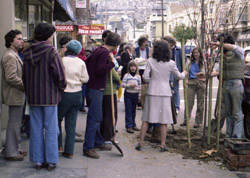
Our first planting, Noe Valley, 1981
One of the five was Brian Fewer, the father-in-law of former District 1 Supervisor Sandra Lee Fewer. Brian deeply loved trees and worked at San Francisco Public Works (SFPW) for most of his career. This started the deep and valuable partnership between SFPW and FUF.
We developed a community planting model, meaning we brought homeowners and volunteers together on one day, usually a Saturday, to transform a neighborhood with new street trees. In many cases, it was a chance for neighbors to meet each other for the first time. We’ve planted almost 60,000 trees this way.
We then would do structural pruning and replace the tree’s support hardware as needed for three years after it was planted. We’re currently doing this for about 3,400 trees per year.
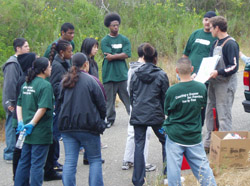
Chris Buck with Youth Tree Care crew (now called Green Teens)
25 years ago, Chris Buck helped to start a program that we now call Green Teens — a job preparedness program for young people between the ages of 14 and 18. They’re paid minimum wage, and we train them in all aspects of arboriculture with a strong emphasis on tree pruning. Each year, 50 to 60 teens participate, and in a good year, they handle close to 25% of our pruning. Chris is now Urban Forester for SFPW.
About 7 years ago, we started our Green Crew, a workforce development program that now employs five young adults, ages 19 to 25. From that program we have now hired four graduates as full-time employees of FUF.

Sidewalk gardens on 25th Street in the Mission neighborhood
About 12 years ago, we launched a Sidewalk Gardens program to create what we call the understory of our urban canopy. We have now replaced more than 10,000 square feet of concrete with beautiful gardens to help capture stormwater, relieve our aging storm-sewer system, and recharge our aquifers.
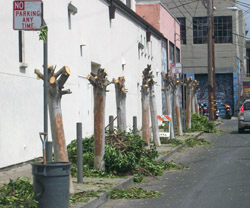
“Topped” trees in the Mission. Incompetent pruning like this was common before the passage of Prop E.
In July of 2017, San Francisco’s urban forest had a seismic change. That’s when Proposition E, the Healthy Trees and Safe Sidewalks Measure, took effect. FUF had run the campaign for Prop E in 2016 and was wildly successful in getting 78.6% of the vote. Prop E ended the disastrous policy of requiring property owners to maintain adjacent street trees, and it created a dedicated funding source in perpetuity to enable the City to care for all street trees, with enough money built in to take care of 30,000 additional trees we intend to plant. This program, now known as StreetTreeSF, is unique in the U.S., and possibly the world.
For FUF, it totally changed our revenue model. Before StreetTreeSF, FUF charged adjacent homeowners a co-payment when we planted street trees. Now that the city owns all of the street trees, we could no longer charge homeowners.
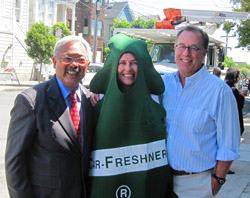
Mayor Ed Lee, Carla Short of San Francisco Public Works, and Dan Flanagan of FUF on the day the StreetTreeSF program began
This was good news and bad news. The good news, of course, was that BUF and FUF could now partner in addressing the systemic inequality of our street tree distribution. Carla Short, Superintendent of the Bureau of Urban Forestry at SFPW, wanted FUF to concentrate much of its planting in underserved communities with very low tree canopy.
The bad news was that FUF became heavily dependent upon City Funding, not only to support our tree planting work, but also to support the care we provide to each tree for three years until it’s established and becomes part of the StreetTreeSF program.
Luckily, FUF was able to secure three separate grants from Cal Fire to help us plant in underserved communities. In July of 2017, we started to focus our plantings in the southeast of the city. Now we had a chance to address the lack of trees in those communities.
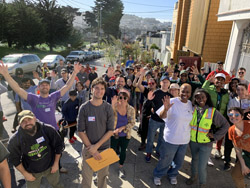
Planting in the OMI neighborhood with the Wright Chapel AME Church
We were already hiring and training youth and young adults from the southeastern part of the city in our workforce development programs. But we needed to change how we conducted our community outreach as we increased the frequency of our plantings in the area.
So we’ve been building relationships with community partners and neighborhood residents and involving them more extensively in our plans to do work in their neighborhoods. We have also begun the process of ensuring that residents of the neighborhoods in which we plant are included in FUF’s permanent staff and leadership. This is an ongoing process.
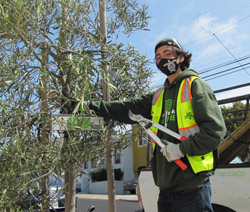
Christian Vasquez, FUF Tree Care Coordinator, pruning a tree in the Excelsior neighborhood
The next milestone of FUF history was March 5, 2020. That afternoon, Carla Short called FUF to say that SFPW was canceling its Arbor Day planting, but that FUF could probably go forward with our planting the next day. By evening, though, we had decided to cancel our planting as well.
Within a week or so, we were all sheltered in place. We spent that whole week figuring out how to shut down our office and shift to working remotely. We also came up with a plan to continue to plant trees only with staff — no volunteers. But we couldn’t plant until the City said it was OK.
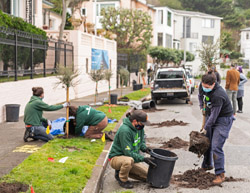
Staff-only planting during pandemic
We were finally able to proceed with staff-only tree planting on July 1. At the same time, we began a program to water the trees we planted for the first time in our history. We hope to water up to 500 trees this year, and we are looking at expanding that in the future.
And just this month, our most highly-trained volunteers joined us for the first time in more than a year to plant trees in small groups. It was a great success, and we’ll continue this new model of limited volunteer participation until we can return to our traditional model of community-based plantings every other week.
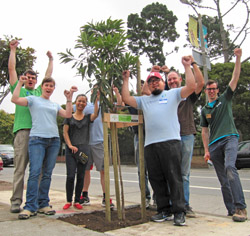
Our 50,000th street tree planted
In summary, we were started by an employee of SFPW, and for the past 40 years we have deepened our partnership with the agency. Our goal is to continue to work alongside SFPW, raising awareness of the importance of trees, advocating for trees in City Hall, and building our audience in order to share the message of the importance of tree planting as a climate change solution.